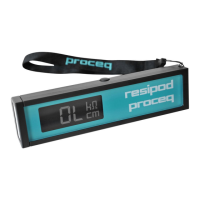4 Resistivity Measurements on Site
4.1 Influences
Influence of rebars on electrical resistivity measurements
The presence of rebars disturbs electrical resistivity measurements as they conduct current much
better than the surrounding concrete. This is particularly the case when the cover depth is less than
30 mm.
As far as possible, reinforcement bars should not be directly beneath the probe and should not
run parallel to the probe. The recommended measurement orientation is determined by the spacing of the
rebars compared with the probe spacing.
The optimum orientation is to measure diagonally to the
rebars as shown. This is possible if the probe span is
less than the rebar grid spacing.
For the Resipod 38 mm, the probe span is
38x3 = 114 mm (4.5”)
For the Resipod 50 mm, the probe span is
50x3 = 150 mm (5.9”)
If the rebar spacing is so close that it cannot be
avoided, the influence of the steel can be minimized by
measuring perpendicular to the rebars as shown.
RILEM TC154-EMC: ELECTROCHEMICAL TECH-
NIQUES FOR MEASURING METALLIC CORROSION
recommends making 5 readings from the same location
moving the probe a few mm between each measure-
ment and taking a median from the 5 values.
Influence of aggregate size
As explained in 2.2, the current flows in the pore liquid of concrete. Ideally the probe spacing
should be larger than the maximum aggregate size as aggregate material is typically non-conduct-
ing. The variable spacing probe supplied with Resipod Geometric should be used for aggregate
sizes larger than the standard probe spacing.
Influence of temperature
The temperature of the concrete should be measured and recorded with resistivity measurements.
Resistivity decreases as the temperature increases. Reference values for resistivity measurements
are typically quoted for 20°C (68°F). Empirical studies have shown that a one degree increase in
temperature can reduce the resistivity by 3% for saturated concrete and 5% for dry concrete.
Influence of moisture content
A higher moisture content lowers the resistivity. This can be due to saturation or due to a change
in the water/cement ratio.

